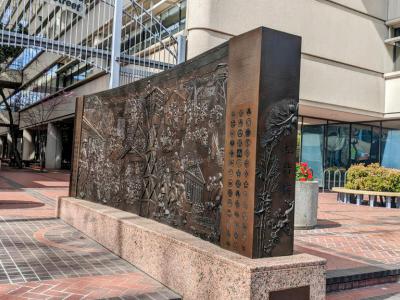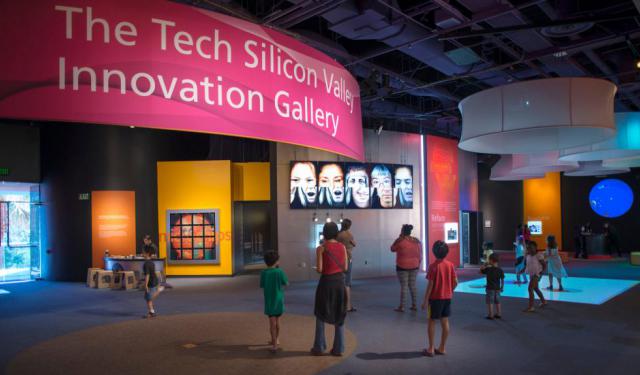Japanese-American Internment Memorial, San Jose
Artist: Ruth Asawa
Year: 1994
Created by Japanese American modernist sculptor Ruth Asawa, this memorial, located outside of the Federal Building, commemorates the forced removal and incarceration of Japanese and Japanese-American residents of California during WWII. Sculpted in bas-relief bronze, the memorial depicts key aspects of the Japanese American experience, before and after the WWII with a central focus on the experience of the incarcerated Japanese Americans during the war.
The mural includes scenes of immigration, community life and agricultural labor and alongside symbols of the incarceration camps, including barracks, barbed wire, a watch tower, and heavily armed soldiers. The whole is accompanied by text panels that include Executive Order no. 9066 by which relocation to internment was ordained, maps of internment camps, and other historical documents. A native Californian, Asawa herself, spent four years at an internment camp in Rohwer, Arkansas along with her family.
While the memorial symbolically commemorates the experience of all Japanese Americans, it has a special poignancy in San José, whose thriving Japanese and Japanese- American community experienced forced removal, incarceration and loss of property as a result of Executive Order no. 9066. Moreover, On May 24 and 25, 1942, San José State University served as a registration site for local residents of Japanese descent prior to their forced removal and incarceration.
The “Japanese Internment Memorial” pushes the view to resist the urge to assign the injustices of the past to the yellowed pages of history. Memorializing the relocation and removal of Japanese Americans during World War II serves as an inflection point for considering the treatment of different groups today – where there is a failure to extend dignity, equality, and justice. The placement of the memorial at the Federal Building recalls the actions of the United States government to act without dignity, equality, and justice and serves as a permanent protest against the violation of civil and human rights.
Make your way by the Plaza de Cesar Chavez, a few other works of public art, and The Tech Museum to see our next interesting artwork located on Paseo de San Antonio, one of the most used passages in downtown. The paseo serves as a focal point for dining, events and theater.
Year: 1994
Created by Japanese American modernist sculptor Ruth Asawa, this memorial, located outside of the Federal Building, commemorates the forced removal and incarceration of Japanese and Japanese-American residents of California during WWII. Sculpted in bas-relief bronze, the memorial depicts key aspects of the Japanese American experience, before and after the WWII with a central focus on the experience of the incarcerated Japanese Americans during the war.
The mural includes scenes of immigration, community life and agricultural labor and alongside symbols of the incarceration camps, including barracks, barbed wire, a watch tower, and heavily armed soldiers. The whole is accompanied by text panels that include Executive Order no. 9066 by which relocation to internment was ordained, maps of internment camps, and other historical documents. A native Californian, Asawa herself, spent four years at an internment camp in Rohwer, Arkansas along with her family.
While the memorial symbolically commemorates the experience of all Japanese Americans, it has a special poignancy in San José, whose thriving Japanese and Japanese- American community experienced forced removal, incarceration and loss of property as a result of Executive Order no. 9066. Moreover, On May 24 and 25, 1942, San José State University served as a registration site for local residents of Japanese descent prior to their forced removal and incarceration.
The “Japanese Internment Memorial” pushes the view to resist the urge to assign the injustices of the past to the yellowed pages of history. Memorializing the relocation and removal of Japanese Americans during World War II serves as an inflection point for considering the treatment of different groups today – where there is a failure to extend dignity, equality, and justice. The placement of the memorial at the Federal Building recalls the actions of the United States government to act without dignity, equality, and justice and serves as a permanent protest against the violation of civil and human rights.
Make your way by the Plaza de Cesar Chavez, a few other works of public art, and The Tech Museum to see our next interesting artwork located on Paseo de San Antonio, one of the most used passages in downtown. The paseo serves as a focal point for dining, events and theater.
Want to visit this sight? Check out these Self-Guided Walking Tours in San Jose. Alternatively, you can download the mobile app "GPSmyCity: Walks in 1K+ Cities" from Apple App Store or Google Play Store. The app turns your mobile device to a personal tour guide and it works offline, so no data plan is needed when traveling abroad.
Japanese-American Internment Memorial on Map
Sight Name: Japanese-American Internment Memorial
Sight Location: San Jose, USA (See walking tours in San Jose)
Sight Type: Statue/Public Art
Guide(s) Containing This Sight:
Sight Location: San Jose, USA (See walking tours in San Jose)
Sight Type: Statue/Public Art
Guide(s) Containing This Sight:
Walking Tours in San Jose, California
Create Your Own Walk in San Jose
Creating your own self-guided walk in San Jose is easy and fun. Choose the city attractions that you want to see and a walk route map will be created just for you. You can even set your hotel as the start point of the walk.
San Jose Museums Tour
The capital of Silicon Valley, San Jose is full of discovery and innovation. Also, steeped in history – established since 1777 – the city has born witness to numerous chapters of American past. When it comes to culture, education and recreation, the local museums are a perfect destination for solo adventurers new to the area.
Here, among other things, you can:
- get hands-on with... view more
Tour Duration: 2 Hour(s)
Travel Distance: 3.9 Km or 2.4 Miles
Here, among other things, you can:
- get hands-on with... view more
Tour Duration: 2 Hour(s)
Travel Distance: 3.9 Km or 2.4 Miles
San Jose Downtown Walking Tour
San Jose is California's third-largest city and the second-largest city in Northern California. From 1849 to 1851, San Jose served as the state's first capital, which is still a local source of pride. The city has formally incorporated in 1850 and has been a center of innovation from the late 19th century, starting with agriculture and food processing.
During World War II, several... view more
Tour Duration: 1 Hour(s)
Travel Distance: 1.9 Km or 1.2 Miles
During World War II, several... view more
Tour Duration: 1 Hour(s)
Travel Distance: 1.9 Km or 1.2 Miles
San Jose Public Art Walking Tour
This walking tour, “Public Art as Resistance in San José,” highlights the history of resistance and public art in downtown San José and begins on the urban university campus, San José State University. Starting from the first two works of art on campus, you’ll find that these 12 works of public art are among many in this area. However, this particular walking tour considers how San... view more
Tour Duration: 3 Hour(s)
Travel Distance: 6.0 Km or 3.7 Miles
Tour Duration: 3 Hour(s)
Travel Distance: 6.0 Km or 3.7 Miles






